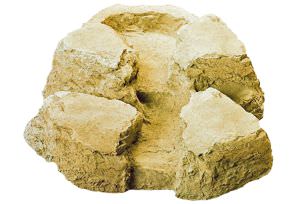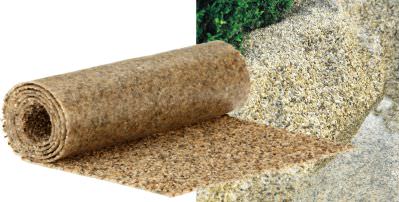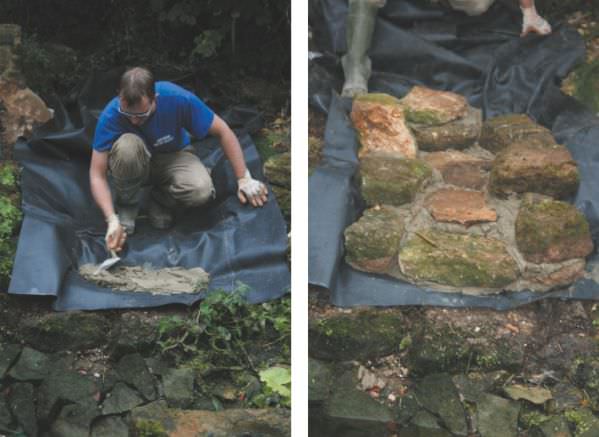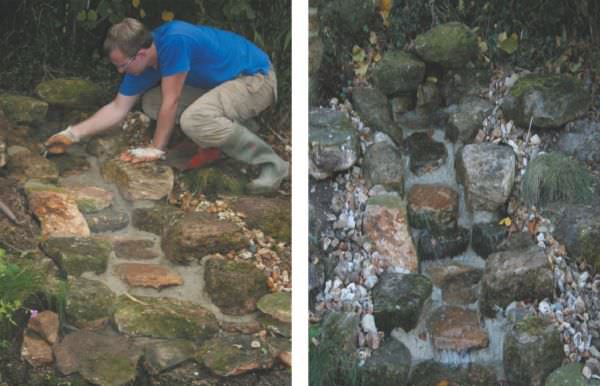Installing a waterfall will add an extra dimension to the beauty of your water garden, as the falling water sparkles in the sunlight while you enjoy the delightful relaxing sound of tumbling water.
Types of Preformed Waterfalls
Plastic. These are the most economic to purchase and are popular with starter ponds or smaller features where space is at a premium. They can look very effective once installed with a few stones and careful planting. Flow rate required 900 to 1800 litres (200 to 400 gallons) per hour.
Fibre Glass & Polyurethane. Very realistic, easy to install, very popular due to their versatility to fit in with landscapes. Generally need a flow rate of 1400 to 4500 litres (300 to 1000 gallons) per hour.

Pre-Cast Stone These spectacular waterfalls can make a most impressive display, with interlocking units being able to create seemingly endless streams, not out of place on the largest of garden ponds.

Pebble Course Liner A flexible liner encrusted with gravel and ideally suited for the construction of streams, waterfalls or edging a pond. Pebble Course Liner is easy to use, allowing you greater flexibility in the design of your watercourse or a more natural finish to ponds, these must be above another pond liner as they are for decorative use only.

How To...
There are many ways to create a waterfall or stream. Using one of the large selection of pre-formed waterfalls illustrated in this manual and available from World of Water is one easy and effective method.
You will find ranges to suit all budgets, pool sizes, rock colour and type. Some cascade units look great on their own, or you may decide to go for a selection of units, which interlock to create a complete stream!
Installing a Preformed Waterfall
Before starting any waterfall project, consider the size of pump required as the higher and wider the waterfall, the larger the pump needed. In simple terms approximately 1,400Ltrs (300 gallons) per hour is required for a 15cm (6") wide fall. All pumps lose volume (flow) the higher you pump the water, so if using an existing pump check it's capacity. If planning to purchase a new pump, ensure it is of adequate power for your waterfall. Check out our pump guide in this manual.
When installing pre-formed waterfalls it is always recommended to conceal a piece of pond liner under the units overlapping into the pond as this will catch any water splash and return it to the pool. The feed hose that is installed should usually be at least 25mm (1 inch) in diameter, but do consult an expert for the correct hose for your pump as a small hose will seriously reduce the potential flow of any pump.
A firm base is required to avoid subsidence. Positioning the units on about 2cm of dry sand and cement mix will hold the units in the desired position. To make any new units look more rustic, it is possible to use some heavy gravel/cobbles and place trailing plants around the units. For further hints on installation, seek advice from one of our experts.
Building Your Own Waterfall

Building your own waterfall from nature rock or stone can give you a personalised and stunning feature. Here are some tips.
Dig out and step the slope as required leaving it a few cm’s deeper than the rocks you're going to use.
Line area with underlay & a single liner ensuring it overlaps the pond. Consider the route for the supply hose.

Starting from the bottom, begin building your waterfall, using flatter stones for the spill lips ensuring the facings are level. Sitting the front lip slightly higher than the back allows water to pool in each step

Continue working up the waterfall, remembering to ensure there is plenty of liner coming up each side of the waterfall. It is usually possible to build the hose outlet into the top, however it is best not to cement this in immediately so it may be adjusted after testing the flow.

Once completed trim the liner so it is higher than any likely water flow. Cement work can be pointed once it has began to cure. An easy way is to use an old paint brush to dab the cement to blend it in as it dries.

Do not run the waterfall for a few days remembering too much cement in the pond can cause health problems so water changes and pH checks may be required.
 British Pounds
British Pounds
